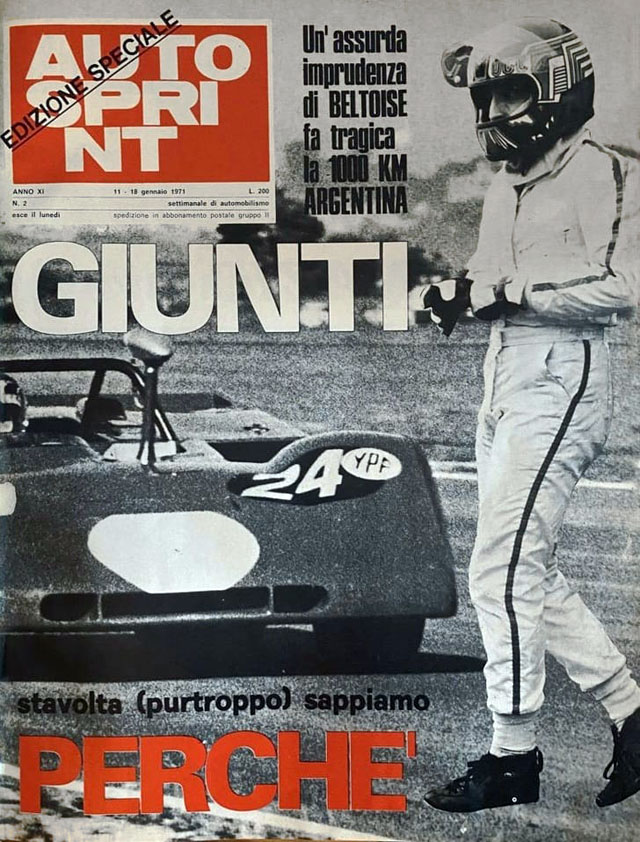–
(30 August 1941 – 10 January 1971: Aged 29)
Designed by Mauro Forghieri
Sponsors: YPF S.A., Yacimientos Petrolíferos Fiscales (in English: Fiscal Oilfields) state-owned Argentine energy company. (It was bought by the Spanish firm Repsol in 1999; the resulting merged company was called Repsol YPF.)
Ignazio Giunti was an Italian racing driver, born in 1941, scion of an aristocratic Roman family with roots in Calabria, region in Southern Italy. Despite coming from a noble family, Giunti was a discreet boy who did not like to live in the spotlight. In Rome, however, he was treated as a “little king”.
At the age of 20, Giunti started with the hill climbs. The first car was a rented Alfa Romeo Giulietta TI. The results were appreciable, the following year he switched to more powerful cars and made his debut in track competitions in Vallelunga, the legendary racetrack, Campagnano di Roma, Italy.
After having shined in minor races he turned professional in 1966, when Alfa Romeo entrusted him with the spectacular Giulia GTA, at the wheel of which he achieved multiple victories, including the 1967 European Mountain Champion title in the Grand Touring category. In 1968, driving for Alfa Romeo, Giunti finished 2nd in the Targa Florio and 4th in the Le Mans 24 Hours race co-driving with Nanni Galli. His reputation became even greater when, at the end of 1969, by virtue of the performances put on showing with the Alfa Romeo 33 in the Makes World Championship, the 28-year-old Roman was called as an official driver by Enzo Ferrari.
As a result, Gunti’s participation in Formula One in the 1970 season was ended only ‘4 races (Belgium, France, Austria and Italy GP)’. Giunti and Arturo Merzario were the great Italian hopes, but in Formula One who stood out the most from the new recruits was Regazzoni with remarkable victory in Monza, Italian GP. However, in the year Giunti had showed the strong performance as a sports car racing driver so he was re-signed by Ferrari for the following season.
Gianti’s first race of the 1971 season was that Buenos Aires 1000 Kilometers. It was the opening round of the 1971 International Championship for Makes season, and took place at the Buenos Aires circuit No.15, Argentina, on January 10, 1971. The Buenos Aires Autodrome had been revamped, with its alternative 6.1 km circuit being used. This was the first World Championship race to have been held in Argentina since Bruce McLaren had won the 1960 Grand Prix there for Cooper. However, this day at the races had become a tragic curtain-raiser for the final 5-litre vs 3-litre World Championship season…
His fate was fulfilled when the Matra 660 driven by Jean Pierre Beltoise ran out of petrol a few hundred meters from the pits, on the 36th lap of the race on 165 laps. He coasted to a halt just before the fast, blind left-hand curve entering the pit straight. He set about pushing his stricken car across the road camber towards the pits, forgetting this would disqualify him. His act caused a dangerous situation in which the following vehicles suddenly had to brake and avoid it. Many cars had to pass him. However, legendary 5 time world champion between 1951 and 1957, Juan Manuel Fangio who was the race director, and the commissioners didn’t prevented him.
On the next lap 37, Beltoise realized what a folly he was committing and tried to pull over towards the guard-rail, when Giunti’s lap leader Ferrari hurtled into the curve behind Mike Parkes’ just-refueled Filipinetti 512M. Parkes managed to avoid the impact by miraculously slipping into the space between the Matra and the internal curb but for Giunti there was in his slipstream, covered in sight and apparently thinking Parkes was giving him room ducked right.
Arturo Merzario, Giunti’s teammate, waiting in the pits, sprinted across to assist the marshals (Even at the time of the Niki Lauda’s horrific accident at the Nurburgring in 1976, the brave Merzario fearlessly stepped into the fire to save his life). Red flags waved and cars stopped, some drivers climbed out. However, it was too late by the time they could pull Giunti clear. The Ferrari was engulfed in flames and Giunti had severe trauma and burns and there was no salvation when he was pulled out of the rubble.
As a result of the third degree burns suffered, at 2:40 PM on that Sunday, Ignazio Giunti is officially declared dead at 29 years old. (Actually Gianti had already been killed instantly with a broken neck, although officially it was declared ‘death in ambulance’ and then ‘death in hospital’.) The consternation and despair in the Ferrari and Alfa Romeo pits (Giunti was also an Alfa Romeo’s “offspring”) turned into revolt and threat of aggression at the French Matra Simca pit which was quickly closed.
As the result, Porsche won with the Gulf team, Siffert/Bell in 1st and Rodriguez/Oliver in 2nd. This horrific accident was attributed to Beltwards’ reckless act of pushing the car towards the pits and Marshall’s missteps. Beltoise was suspended for a few months by the FIA.



